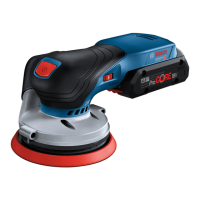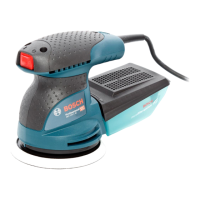6 | English
Random orbit sanders GET 75-150 GET 55-125
No-load speed n
0
min
-1
3300–7300 3300–7800
No-load orbital stroke rate min
-1
6600–14,600 6600–15,600
Sanding pad speed during coarse sanding min
-1
290–640 200–480
Orbit diameter mm 4.5 3.5
Sanding pad diameter mm 150 125
Weight according to EPTA-Procedure
01:2014
kg 2.6 2.4
Protection class
/ II / II
The specifications apply to a rated voltage [U] of 230 V. These specifications may vary at different voltages and in country-specific models.
Assembly
u Pull the plug out of the socket before carrying out any
work on the power tool.
Changing the Sanding Sheet
To remove the sanding sheet (8), lift it from the side and pull
it from the sanding pad (11).
Remove dirt and dust from the sanding pad (11), e.g. with a
paintbrush, before attaching a new sanding sheet.
The surface of the sanding pad (11) is fitted with a hook-
and-loop fastening, allowing sanding sheets with a hook-
and-loop backing to be secured quickly and easily.
Press the sanding sheet (8) firmly onto the underside of the
sanding pad (11).
To ensure optimum dust extraction, make sure that the
punched holes in the sanding sheet (8) are aligned with the
drilled holes in the sanding pad (11).
Selection of the Sanding Plate
The power tool can be fitted with sanding pads of various
hardnesses, depending on the application:
– Extra soft sanding pad: Suitable for polishing and sensit-
ive sanding even on curved surfaces
– Soft sanding pad: Suitable for all sanding work, universal
application
– Hard sanding pad: Suitable for heavy sanding on flat sur-
faces
Changing the Sanding Pad
Note: Replace damaged sanding pads (11) immediately.
Remove the sanding sheet or polishing tool. Unscrew the
screw (10) completely and remove the sanding pad (11).
Attach the new sanding pad (11) and retighten the screw so
that it is finger-tight.
Note: Pads with diameters of 150 mm and 125 mm have dif-
ferent carriers. The pads can only be fitted to the right power
tool.
Note: When attaching the sanding pad, make sure that the
teeth of the catch mate with the recesses in the sanding pad.
Note: Damaged sanding pads must only be replaced by an
after-sales service centre authorised to work with Bosch
power tools.
Dust/Chip Extraction
The dust from materials such as lead paint, some types of
wood, minerals and metal can be harmful to human health.
Touching or breathing in this dust can trigger allergic reac-
tions and/or cause respiratory illnesses in the user or in
people in the near vicinity.
Certain dusts, such as oak or beech dust, are classified as
carcinogenic, especially in conjunction with wood treatment
additives (chromate, wood preservative). Materials contain-
ing asbestos may only be machined by specialists.
– Use a dust extraction system that is suitable for the ma-
terial wherever possible.
– Provide good ventilation at the workplace.
– It is advisable to wear a P2 filter class breathing mask.
The regulations on the material being machined that apply in
the country of use must be observed.
u Avoid dust accumulation at the workplace. Dust can
easily ignite.
When sanding, it is recommended that you connect the
power tool to a dust extractor. The power tool has no blower
of its own; dust bags cannot be used.
External Dust Extraction
Connect the extraction hose (accessory) either to the extrac-
tion pipe (3) or directly to the extraction outlet (4) of the
power tool.
Note: The extraction pipe(3) consists of antistatic material.
If an antistatic extraction hose (accessory) is used in addi-
tion, this will prevent an electrostatic charge from building
on the tool, which can happen on occasion when sanding.
When working without dust extraction (e.g. polishing), you
can remove the extraction pipe (3). To do this, press the re-
lease button (15) and pull the extraction pipe (3) backward
out of the power tool.
The dust extractor must be suitable for the material being
worked.
When extracting dry dust that is especially detrimental to
health or carcinogenic, use a special dust extractor.
Auxiliary Handle
The auxiliary handle (5) enables comfortable handling and
optimum power distribution, with a high sanding removal
rate in particular.
1 609 92A 5G0 | (04.11.2019) Bosch Power Tools

